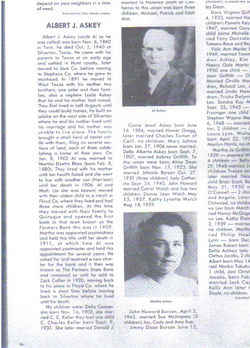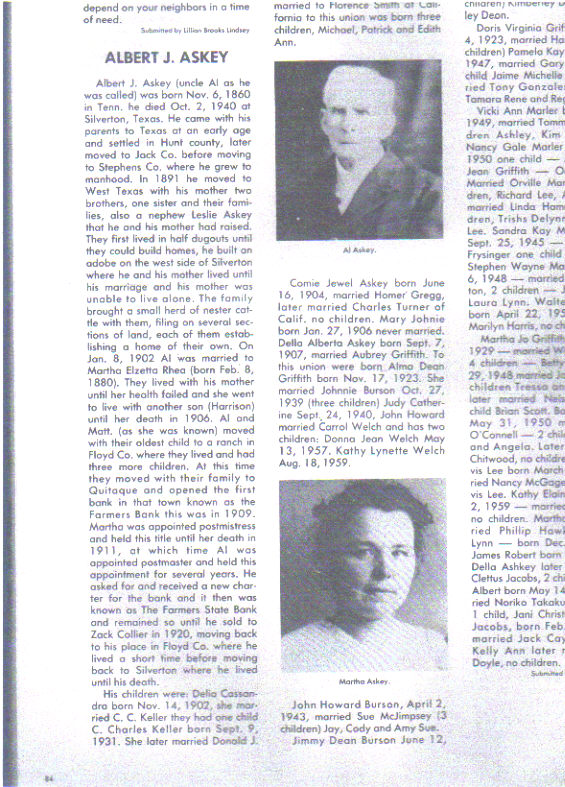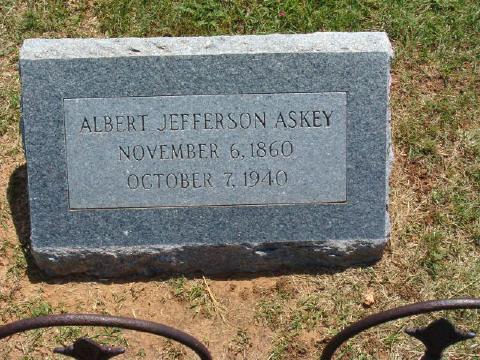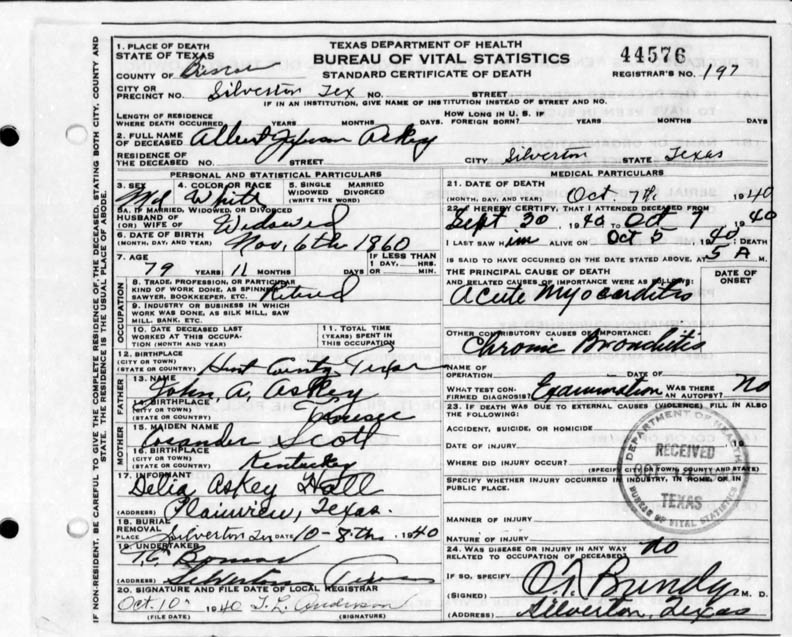Memoirs of A. J. Askey of Silverton:
"I was born November 6, 1860 in Hunt County Texas. I lived in Hunt County until 1865. My father owned cattle and horses. When I was three years old, my brothers would take me with them on cow hunts. I thought it was lots of fun, but to them it was hard work.
In the summer of 1866 we moved to Fannin County, My father hired the soldiers to guard our wagons through Jernigan Thicket to keep the bush whackers away. When we got to the thicket, we penned the stock and the wagons went through to camp on the other side. As we came back through the thicket all the boys shot their guns. The soldiers all but one, ran away from the wagons and we never saw them again.
At that time, 1866, the bush whackers were pretty numerous. The people we stopped with in Fannin County had just had four of their family waylaid and killed. My father, not liking such conditions, decided to leave the state. He and my older brothers rounded up 200 steers and turned them over to a man to take to Arkansas to sell. We left all of our other cattle in Fannin County. We just drove off and left them for any one who wanted to gather them up. When we got to Arkansas the man had sold the steers and ran away with the money.
We stayed all winter in the Bosque Mountains. The older boys ran a grist mill to make a living for the family. We moved from there to Benton County, Arkansas and made a crop. My father later bought a place near Pineville, Missouri. The place got it's name from the pine forests near by. We lived there one winter and the boys worked at the saw mill and freighted for supplies.
We did not like Missouri very well so the next spring, 1868 I think, we started for Texas again. We stopped in Ellis County and raised a cotton crop. The boys freighted to Beaumont. From there we went to Denton County. We had bought as many cattle as our finances would permit and were anxious to go farther west. In 1870 we moved to Dallas County. The older boys all got jobs so I had to herd the cattle. I was then ten years old and made my own start in the cattle business as one of the men for whom I herded cattle gave me a cow and calf.
I never had a pair of breeches, shoes, or a hat until I was six years old. All I had in the way of clothes were things my mother could make. The first hat I ever owned was bought in Sherman. My brother gave me the hat in the afternoon and before night I had lost it. That was a real tragedy in my life.
We moved to Wise County in 1872. The Indians camped in the thickets near our place. They stole milk from our spring and they made two raids while we were there. They stole 75 mules from one of our neighbors. They killed three women, and, as the men were so hot on their trail, they ran off and left the mules. I wished to go with the men to hunt the Indians, but I had to stay near home and herd the cattle and what horses were left.
A few of the older boys that were not in the Indian chase decided to scare me. They wrapped themselves in red blankets and whooped and yelled from a nearby hilltop to attract my attention. Thinking they were real Indians after the stock and that they would kill me, I jumped on my horse and started for home. The boys teased me about it for a long time.
In those days cattle just roamed the country. There were no wire fences nor fences of any kind to stop the cows. It was every fellow for himself. When a cow or calf went into a herd unbranded, it was caught and branded with that herd. As years passed all of the cattle were branded other than the calves. They had to be watched closely or they would be stolen.
We moved from one place to another most of my young life. When I was 18, I went to Callahan County. There I had my first real job and supported myself. I helped to round up the Hash-Knife herd of cattle. There were about 12,000 head in the herd. It took 300 men to herd them. That was the largest herd of cattle that I have ever seen. They brought out 8 or 10 men from Fort Worth to help with the night herding. They didn't know a thing about cattle. All of the old hands made it up to initiate the tender-feet. We all ran off and left them alone. The new hands were scared to death. They hollered and wandered all up and down the creek trying to find the camp.
In 1883 we moved to Stevens County and lived there 8 years. When we went out on a round up, we would leave home in the early spring and not return until late summer. We went down in Commanche County gathering up cattle. The night we got there, two men had been hung. To my great surprise one of them was a man whom I had played with when we were small boys. They had been horse thieves.
We moved to Briscoe County in 1891. The country was all under fence by Goodnight. I brought 50 head of cattle with me and in ten years I had 600 head and 8 sections of land.
There were no towns in Briscoe County at all. The county was organized in 1892 and Silverton became the county seat. We freighted all of our supplies from Amarillo then, and it was a very small place.
Memoirs of A. J. Askey of Silverton:
"I was born November 6, 1860 in Hunt County Texas. I lived in Hunt County until 1865. My father owned cattle and horses. When I was three years old, my brothers would take me with them on cow hunts. I thought it was lots of fun, but to them it was hard work.
In the summer of 1866 we moved to Fannin County, My father hired the soldiers to guard our wagons through Jernigan Thicket to keep the bush whackers away. When we got to the thicket, we penned the stock and the wagons went through to camp on the other side. As we came back through the thicket all the boys shot their guns. The soldiers all but one, ran away from the wagons and we never saw them again.
At that time, 1866, the bush whackers were pretty numerous. The people we stopped with in Fannin County had just had four of their family waylaid and killed. My father, not liking such conditions, decided to leave the state. He and my older brothers rounded up 200 steers and turned them over to a man to take to Arkansas to sell. We left all of our other cattle in Fannin County. We just drove off and left them for any one who wanted to gather them up. When we got to Arkansas the man had sold the steers and ran away with the money.
We stayed all winter in the Bosque Mountains. The older boys ran a grist mill to make a living for the family. We moved from there to Benton County, Arkansas and made a crop. My father later bought a place near Pineville, Missouri. The place got it's name from the pine forests near by. We lived there one winter and the boys worked at the saw mill and freighted for supplies.
We did not like Missouri very well so the next spring, 1868 I think, we started for Texas again. We stopped in Ellis County and raised a cotton crop. The boys freighted to Beaumont. From there we went to Denton County. We had bought as many cattle as our finances would permit and were anxious to go farther west. In 1870 we moved to Dallas County. The older boys all got jobs so I had to herd the cattle. I was then ten years old and made my own start in the cattle business as one of the men for whom I herded cattle gave me a cow and calf.
I never had a pair of breeches, shoes, or a hat until I was six years old. All I had in the way of clothes were things my mother could make. The first hat I ever owned was bought in Sherman. My brother gave me the hat in the afternoon and before night I had lost it. That was a real tragedy in my life.
We moved to Wise County in 1872. The Indians camped in the thickets near our place. They stole milk from our spring and they made two raids while we were there. They stole 75 mules from one of our neighbors. They killed three women, and, as the men were so hot on their trail, they ran off and left the mules. I wished to go with the men to hunt the Indians, but I had to stay near home and herd the cattle and what horses were left.
A few of the older boys that were not in the Indian chase decided to scare me. They wrapped themselves in red blankets and whooped and yelled from a nearby hilltop to attract my attention. Thinking they were real Indians after the stock and that they would kill me, I jumped on my horse and started for home. The boys teased me about it for a long time.
In those days cattle just roamed the country. There were no wire fences nor fences of any kind to stop the cows. It was every fellow for himself. When a cow or calf went into a herd unbranded, it was caught and branded with that herd. As years passed all of the cattle were branded other than the calves. They had to be watched closely or they would be stolen.
We moved from one place to another most of my young life. When I was 18, I went to Callahan County. There I had my first real job and supported myself. I helped to round up the Hash-Knife herd of cattle. There were about 12,000 head in the herd. It took 300 men to herd them. That was the largest herd of cattle that I have ever seen. They brought out 8 or 10 men from Fort Worth to help with the night herding. They didn't know a thing about cattle. All of the old hands made it up to initiate the tender-feet. We all ran off and left them alone. The new hands were scared to death. They hollered and wandered all up and down the creek trying to find the camp.
In 1883 we moved to Stevens County and lived there 8 years. When we went out on a round up, we would leave home in the early spring and not return until late summer. We went down in Commanche County gathering up cattle. The night we got there, two men had been hung. To my great surprise one of them was a man whom I had played with when we were small boys. They had been horse thieves.
We moved to Briscoe County in 1891. The country was all under fence by Goodnight. I brought 50 head of cattle with me and in ten years I had 600 head and 8 sections of land.
There were no towns in Briscoe County at all. The county was organized in 1892 and Silverton became the county seat. We freighted all of our supplies from Amarillo then, and it was a very small place.
Family Members
Sponsored by Ancestry
Advertisement
Explore more
Sponsored by Ancestry
Advertisement
















